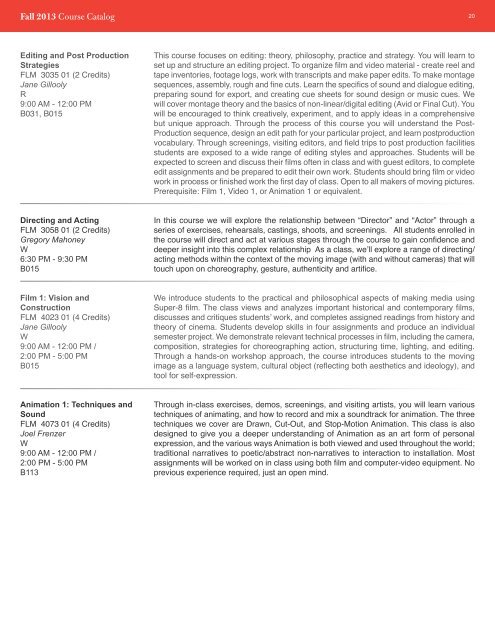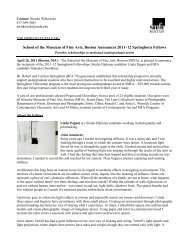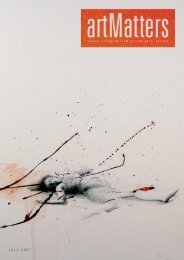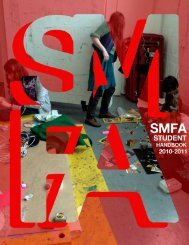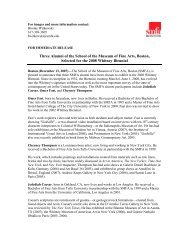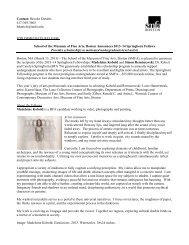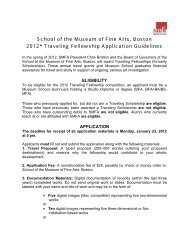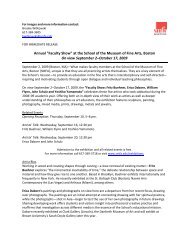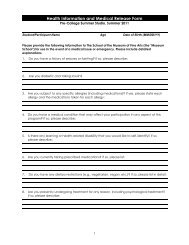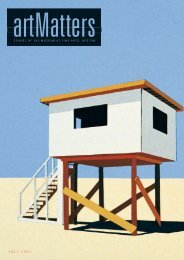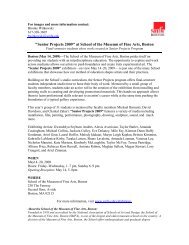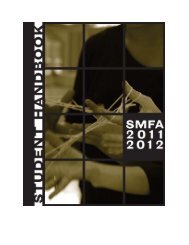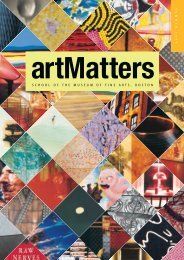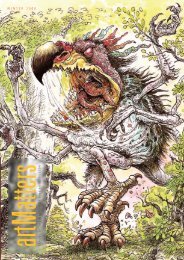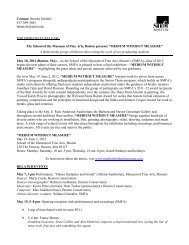Fall 2013 Course Catalog - School of the Museum of Fine Arts
Fall 2013 Course Catalog - School of the Museum of Fine Arts
Fall 2013 Course Catalog - School of the Museum of Fine Arts
You also want an ePaper? Increase the reach of your titles
YUMPU automatically turns print PDFs into web optimized ePapers that Google loves.
<strong>Fall</strong> <strong>2013</strong> <strong>Course</strong> <strong>Catalog</strong><br />
20<br />
Editing and Post Production<br />
Strategies<br />
FLM 3035 01 (2 Credits)<br />
Jane Gillooly<br />
R<br />
9:00 AM - 12:00 PM<br />
B031, B015<br />
This course focuses on editing: <strong>the</strong>ory, philosophy, practice and strategy. You will learn to<br />
set up and structure an editing project. To organize film and video material - create reel and<br />
tape inventories, footage logs, work with transcripts and make paper edits. To make montage<br />
sequences, assembly, rough and fine cuts. Learn <strong>the</strong> specifics <strong>of</strong> sound and dialogue editing,<br />
preparing sound for export, and creating cue sheets for sound design or music cues. We<br />
will cover montage <strong>the</strong>ory and <strong>the</strong> basics <strong>of</strong> non-linear/digital editing (Avid or Final Cut). You<br />
will be encouraged to think creatively, experiment, and to apply ideas in a comprehensive<br />
but unique approach. Through <strong>the</strong> process <strong>of</strong> this course you will understand <strong>the</strong> Post-<br />
Production sequence, design an edit path for your particular project, and learn postproduction<br />
vocabulary. Through screenings, visiting editors, and field trips to post production facilities<br />
students are exposed to a wide range <strong>of</strong> editing styles and approaches. Students will be<br />
expected to screen and discuss <strong>the</strong>ir films <strong>of</strong>ten in class and with guest editors, to complete<br />
edit assignments and be prepared to edit <strong>the</strong>ir own work. Students should bring film or video<br />
work in process or finished work <strong>the</strong> first day <strong>of</strong> class. Open to all makers <strong>of</strong> moving pictures.<br />
Prerequisite: Film 1, Video 1, or Animation 1 or equivalent.<br />
Directing and Acting<br />
FLM 3058 01 (2 Credits)<br />
Gregory Mahoney<br />
W<br />
6:30 PM - 9:30 PM<br />
B015<br />
In this course we will explore <strong>the</strong> relationship between “Director” and “Actor” through a<br />
series <strong>of</strong> exercises, rehearsals, castings, shoots, and screenings. All students enrolled in<br />
<strong>the</strong> course will direct and act at various stages through <strong>the</strong> course to gain confidence and<br />
deeper insight into this complex relationship As a class, we’ll explore a range <strong>of</strong> directing/<br />
acting methods within <strong>the</strong> context <strong>of</strong> <strong>the</strong> moving image (with and without cameras) that will<br />
touch upon on choreography, gesture, au<strong>the</strong>nticity and artifice.<br />
Film 1: Vision and<br />
Construction<br />
FLM 4023 01 (4 Credits)<br />
Jane Gillooly<br />
W<br />
9:00 AM - 12:00 PM /<br />
2:00 PM - 5:00 PM<br />
B015<br />
We introduce students to <strong>the</strong> practical and philosophical aspects <strong>of</strong> making media using<br />
Super-8 film. The class views and analyzes important historical and contemporary films,<br />
discusses and critiques students’ work, and completes assigned readings from history and<br />
<strong>the</strong>ory <strong>of</strong> cinema. Students develop skills in four assignments and produce an individual<br />
semester project. We demonstrate relevant technical processes in film, including <strong>the</strong> camera,<br />
composition, strategies for choreographing action, structuring time, lighting, and editing.<br />
Through a hands-on workshop approach, <strong>the</strong> course introduces students to <strong>the</strong> moving<br />
image as a language system, cultural object (reflecting both aes<strong>the</strong>tics and ideology), and<br />
tool for self-expression.<br />
Animation 1: Techniques and<br />
Sound<br />
FLM 4073 01 (4 Credits)<br />
Joel Frenzer<br />
W<br />
9:00 AM - 12:00 PM /<br />
2:00 PM - 5:00 PM<br />
B113<br />
Through in-class exercises, demos, screenings, and visiting artists, you will learn various<br />
techniques <strong>of</strong> animating, and how to record and mix a soundtrack for animation. The three<br />
techniques we cover are Drawn, Cut-Out, and Stop-Motion Animation. This class is also<br />
designed to give you a deeper understanding <strong>of</strong> Animation as an art form <strong>of</strong> personal<br />
expression, and <strong>the</strong> various ways Animation is both viewed and used throughout <strong>the</strong> world;<br />
traditional narratives to poetic/abstract non-narratives to interaction to installation. Most<br />
assignments will be worked on in class using both film and computer-video equipment. No<br />
previous experience required, just an open mind.


